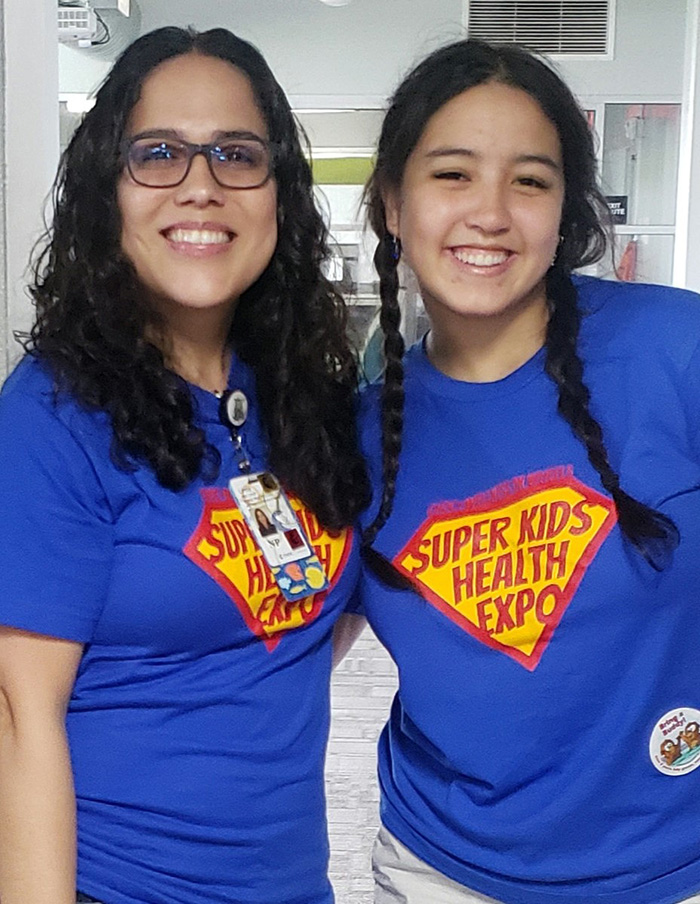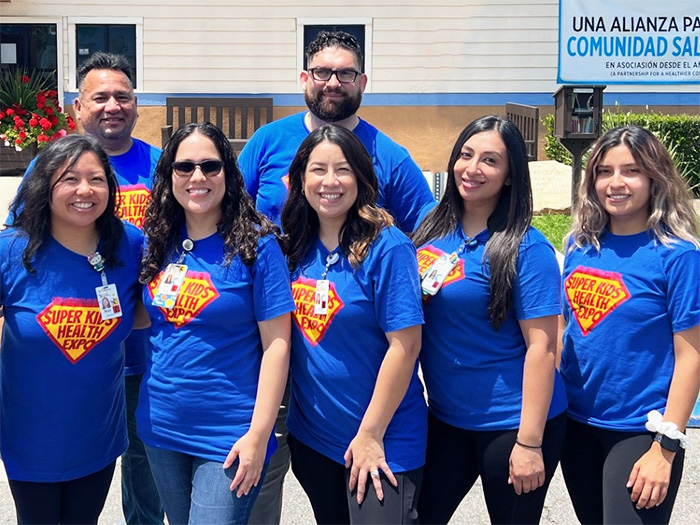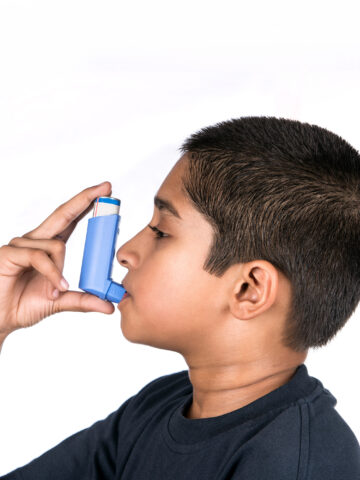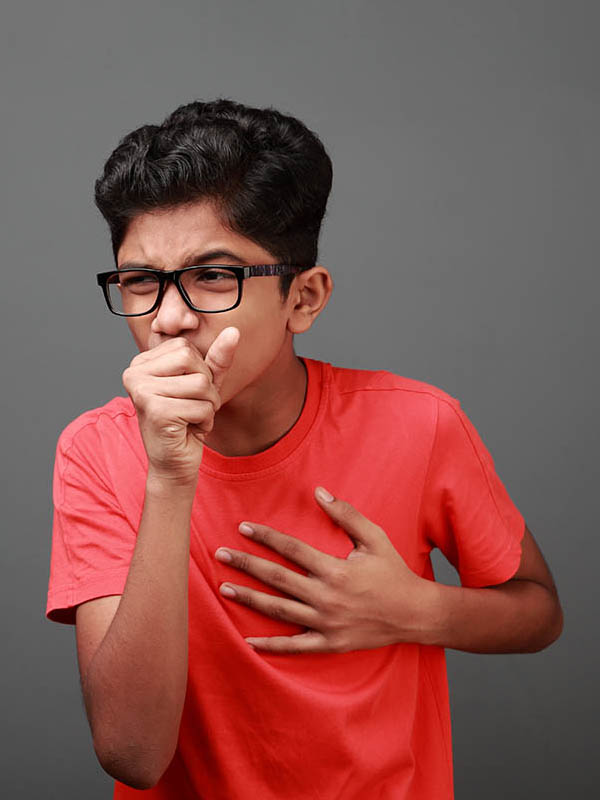Kayla Gomez stepped into the van for her medical appointment.
Diagnosed with asthma when young, she’s been seeing CHOC specialists for a decade.
On this weekday, Kayla, a first-year biology student at Cal State Fullerton, only had to drive a short 10 minutes from her home in south Orange County to the Laguna Hills Community Center to get a skin allergy test.
There, in the parking lot for six hours, CHOC’s Wellness on Wheels (WoW) van remained stationed.
Reimagined from its former identity in 2022 as the Breathmobile, a mobile neighborhood and community-based pediatric program, WoW still exclusively serves patients with asthma.
But soon, it’s poised to expand its services to include social needs screenings, health education on nutrition and physical activity, obesity prevention and treatment, mental health topics, and more.
In addition, two key members of the WoW team – Dr. Clarisse Casilang and Pediatric Nurse Practitioner Linda Mendoza – are involved in an innovative study of a remote monitoring platform designed to make sure asthma patients regularly take their medication to prevent serious attacks.

It’s all good news for the 800 to 1,000 mostly Latinx children WoW serves each year. In the most recent fiscal year, WoW logged more than 2,800 patient visits, making it a critical program in CHOC’s mission to bring patient care, education, outreach and research directly to communities.
“Definitely, this makes my life easier,” Kayla says. “I have a hectic schedule, and coming here is very convenient. The care team is amazing. I look forward to this type of doctor appointment.”
Two ideal leaders
When the COVID-19 pandemic hit in 2020 and put the WoW program and its three vans on ice for a year after more than two decades of success, discussions to expand WoW’s services and launch the remote monitoring study began.
Both ideas support the concept of preventing disease rather than waiting for kids to get sick.
CHOC leaders in population health and primary care continue to make plans to grow the community services the WoW vans offer, in consultation with physicians, sub-specialists, social workers and others.
Dr. Casilang, who joined CHOC in 2019 and is its community pediatrics lead physician, was born for her role as WoW’s top provider.
After training in pediatrics, she spent two years on a global health fellowship in the Dominican Republic, caring for kids with HIV and other children with limited access to medical care.
“That experience opened my eyes,” Dr. Casilang says. “Through lots of partnerships and collaboration, we were able to create a sustainable model that is on par with healthcare in the United States.
“All the things I learned during my fellowship really apply to this position,” adds Dr. Casilang, who is fluent in English, Tagalog and Spanish. “We don’t just engage in clinical work – we conduct research and outreach using a community-based healthcare model.”
Partnerships are also key to WoW. One of its biggest donors and supporters is the CHOC Foundation Latino Advisory Council, which has held two fundraising events to fund programming and a new sprinter van. WoW also receives funding through grants, including one from the Orange County Health Care Agency designed to address healthcare disparities.
Linda is a seasoned WoW leader, with nearly 12 years of service to underserved children with asthma and their families. She’s a certified pediatric nurse practitioner and a certified asthma educator. Linda has a master’s degree in nursing from Cal State Long Beach and, this May, is set to earn a doctorate in nursing practice.
“We’re trying to help support these families by meeting them where they are at,” says Linda, who helped treat Kayla and nearly a dozen other patients who visited the 36-foot van in a parking lot at the Laguna Hills Community Center.
Every one to four weeks, a WoW vehicle visits 15 sites in Orange County, from Fullerton to Garden Grove to Dana Point.
Addressing non-adherence
During the COVID-19 shutdown of WoW, the team pivoted and focused on research to improve asthma management in the most vulnerable populations.
They turned to a digital healthcare company that developed an FDA-cleared therapeutic platform that includes sensors to track medications, a mobile app or online portal, and personalized support and coaching.
Under the mentorship of pediatric allergist Dr. Stanley Galant, who founded Breathmobile over 20 years ago, Linda launched a feasibility study on the platform’s efficacy with asthma patients from WoW, who are predominantly from underserved communities.

Linda met with Jennifer Hayakawa, DNP, director of nursing research and innovation at CHOC, who connected her to nurse scientist Jennifer Barrows, PhD, RN, and Paulina Schuhler, a clinical research nurse coordinator, when research got underway. Also contributing to the study was biostatistician Tricia Morphew.
Dr. Casilang also got involved in the study; her fellowship project explored how mobile technology could enhance breastfeeding education in under-resourced communities.
Paper presentation at CHOC Research Day
At CHOC Research Day 2023, Linda presented a research poster on the study, “Feasibility of Remote Patient Monitoring to Improve Childhood Asthma.”
Asthma is the most common chronic condition in kids under 18 years old, affecting about 4 million (about 9%) kids in the U.S., Linda explained, but it’s also one of the most disparate health conditions, affecting Latinx and Black people much more than White people
Inhaled corticosteroid medications are critical to controlling asthma, Linda said, but 50 to 80 percent of kids do not adhere to treatment.
That’s where remote patient monitoring (RPM) comes in. It allows parents and kids to track medication adherence, rescue inhaler use, asthma symptoms and triggers.
Until now, RPM has not been studied much in children with asthma from underserved communities, Linda says.
In the six-month feasibility study performed in WoW mobile clinics, study leaders recruited 20 children ages 5 to 17 with poorly controlled asthma. The study concluded that kids and their parents were interested in the use of RPM, and that a lack of access to technology did not limit participation in the sample of low-income, minority children.
Still to be collected this summer is data on patient and clinician satisfaction, Linda says.
“We want to talk to parents to glean some qualitative data, ask them about their experience, and see if the app can be improved,” she explains.
Also to be determined is the effect of RPM on inhaled corticosteroids adherence, but the feasibility study concluded it was 52 percent greater than or equal to in the first three months patients were tracked.
‘Heart and soul’ of WoW
In addition to Linda and Dr. Casilang, several staff members run the WoW program.
They are program supervisor Thalia Ramirez; Steve Ramirez, a patient service representative who drives and maintains the WoW vehicles, engages in outreach, and also serves as resident DJ for WoW’s annual health fair; Angelina Holguin, LVN; Lilian Rivas, LVN; social worker Luz Najera; and Yesenia Pena, a community health worker and patient service representative.
“They make up the heart and soul of the program,” Dr. Casilang says.
Dr. Olga Guijon is WoW’s former lead physician.
“The Breathmobile/WOW program has been successful by establishing a trusting partnership with the families and communities that the program serves,” says Dr. Guijon, who now oversees all of CHOC’s primary care clinics as the Division Chief of Primary Care.
“WoW not only meets patients where they are geographically,” Dr. Guijon adds, “but meets them where they are in their asthma journey and by addressing any barriers or challenges they may face.”
Learn more about CHOC’s Wellness on Wheels (WoW) program




